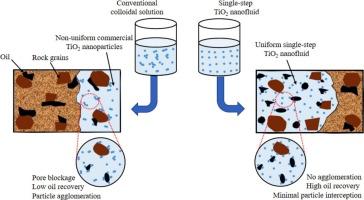轻质石蜡原油TiO2-PAM纳米流体的合成、流变性能及应用潜力的实验研究
IF 4.6
3区 材料科学
Q2 MATERIALS SCIENCE, MULTIDISCIPLINARY
引用次数: 0
摘要
纳米流体的性能经常受到过早相分离、团聚和粒径控制的影响。单步合成无团聚、尺寸无关、高度稳定的纳米颗粒,既不需要大量的超声/能量,也使用经济高效的前驱体/加速器。因此,在本研究中,通过溶胶-凝胶法制备了尺寸(20 ~ 100 nm)和浓度(0.04 wt%-0.4 wt%)的稳定TiO2纳米流体,其中包括(a)恒定浓度(0.04 wt%)的TTIP + 0.5-1.5 ml的NH4OH (I型纳米流体:T1、T2和T3)和(b)恒定浓度(1 ml)的NH4OH + 0.1 wt%-0.4 wt%的TTIP (II型纳米流体:T4、T5和T6)。纳米流体表现出更好的ζ电位(- 53 ~ - 69 mV),然而,DLS、UV-vis和电导率结果证实,在80 d (- 37 ~ - 60 mV)的储存期间,由于NP沉降导致相分离。进一步分析了纳米流体对4种石蜡的IFT还原作用。此外,通过多孔介质润湿性变化的接触角测试,检查了它们在页岩、沙滩砂和砂岩表面的扩散情况。所有纳米流体对岩石表面都有一定的润湿作用,但页岩、滩砂和砂岩的优先润湿顺序分别为T2、T3和T1。对于II型纳米流体,T4、T5和T6分别在页岩、沙滩砂和砂岩中具有相似的优先润湿性。最后,在30°C和90°C下进行粘度和G '测试,以了解热能对纳米流体流变性能的影响。纳米流体是具有经典剪切变薄行为的粘性液体,并且由于从低到高应变水平(1 - 100%)主导G ',它们表现出凝胶状性质。热对纳米流体粘度和弹性性质的影响是不同的,因为小颗粒纳米流体的粘度和G′的降低程度比大颗粒或浓度大的纳米流体最小。本文章由计算机程序翻译,如有差异,请以英文原文为准。

Experimental investigations on synthesis, rheological characterization, and application potential of TiO2-PAM nanofluids for light paraffinic crude oil
The performance of nanofluid is often affected by premature phase separation, agglomeration, and uncontrolled size. Single-step offers a synthesis of agglomeration-free, size-independent, and highly stable nanoparticles which neither demands for extensive sonication/energy but also uses a cost-effective precursor/accelerator. Thus, in this study, stable TiO2 nanofluids of customized size (20 to 100 nm) and concentration (0.04 wt%-0.4 wt%) were prepared via a sol–gel method that involves (a) constant concentration (0.04 wt%) of TTIP + 0.5–1.5 ml of NH4OH (type I nanofluids: T1, T2, and T3) and (b) constant concentration (1 ml) of NH4OH + 0.1 wt%-0.4 wt% of TTIP (type II nanofluids: T4, T5, and T6). The nanofluids exhibited better zeta-potential (−53 to −69 mV) however, phase separation occurred due to NP settlement over the storage period of 80 d (−37 to −60 mV) as validated by the results of DLS, UV–vis, and electrical conductivity. Further, nanofluids were analysed for IFT reduction of 4 kinds of paraffin. Moreover, their spreading on the surface of shale, beach sand, and sandstone was checked via contact angle tests for wettability alteration in porous media. All nanofluids showed some wetting for rock surface however, the order of preferential wetting for shale, beach sand, and sandstone was T2, T3, and T1, respectively. With type II nanofluids, T4, T5, and T6 ranked for similar preferential wetting in shale, beach sand, and sandstone, respectively. Finally, viscosity and G′ tests were conducted at 30 and 90 °C, to understand the impact of thermal energy on the rheological properties of nanofluids. Nanofluids were viscous liquids with classical shear-thinning behaviour, and they exhibited a gel-like nature due to dominating G′ from low to high levels of strain (1–100 %). The thermal impact on viscosity and elastic nature of nanofluids was found variable as nanofluids of smaller particles had the least reduction in viscosity and G′ than the one of large particles or large concentration.
求助全文
通过发布文献求助,成功后即可免费获取论文全文。
去求助
来源期刊

Materials Science and Engineering: B
工程技术-材料科学:综合
CiteScore
5.60
自引率
2.80%
发文量
481
审稿时长
3.5 months
期刊介绍:
The journal provides an international medium for the publication of theoretical and experimental studies and reviews related to the electronic, electrochemical, ionic, magnetic, optical, and biosensing properties of solid state materials in bulk, thin film and particulate forms. Papers dealing with synthesis, processing, characterization, structure, physical properties and computational aspects of nano-crystalline, crystalline, amorphous and glassy forms of ceramics, semiconductors, layered insertion compounds, low-dimensional compounds and systems, fast-ion conductors, polymers and dielectrics are viewed as suitable for publication. Articles focused on nano-structured aspects of these advanced solid-state materials will also be considered suitable.
 求助内容:
求助内容: 应助结果提醒方式:
应助结果提醒方式:


